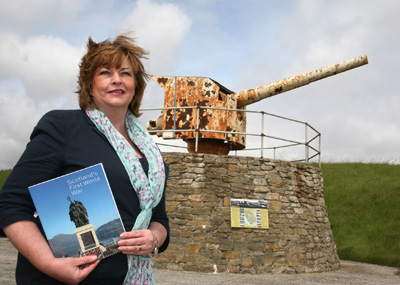New book charts Scotland’s links to First World War

An extensively illustrated new book exploring the physical legacy of the Great War in Scotland was launched in Orkney.
Scotland’s First World War follows an audit of buildings and structures from the period, which was commissioned by Historic Scotland and the Royal Commission on the Ancient and Historical Monuments of Scotland in 2013.
This identified the surprising wealth and variety of buildings and monuments across the country - over 900 in all - greatly increasing our understanding of the impact of the conflict in Scotland.
In many cases their First World War connections were previously unknown. The new book explores what this tells us about the scale and achievements of the war effort in Scotland.
It includes archive images of military bases, personnel and equipment, as well as lesser-known aspects of the war, such as drill halls, prisoner of war camps, and hospitals. It shows how the conflict touched all communities in the country at the time and illustrates the range of work undertaken to protect the country from enemy attack and prepare Scotland’s soldiers for war.
Scotland’s First World War was launched by Fiona Hyslop, Cabinet Secretary for Culture and External Affairs, during a visit to Lyness and Scapa Flow in Orkney.
The naval site at Lyness has significant connections to WWI, when Scapa Flow was the base of the British Grand Fleet.
Now home to a visitor centre, it houses poignant and sometimes very personal artefacts from Royal Navy ships anchored in Scapa Flow during the war, and from the German High Seas Fleet, which was interned here after the Armistice and scuttled by its German crews in 1919.
Fiona Hyslop said: “As we approach the centenary of the outbreak of the conflict, it is important that we reflect on the sacrifice and immense efforts of our forebears in defence of our country.
“This is something we will be forever grateful for. It is equally important to appreciate the tangible remainders of that conflict that still exist in our historic environment. Much has already been written about the First World War, but we still have a lot to learn.
“Scotland’s First World War will prove invaluable to our education and understanding of how every community played its part during World War One. I hope people of all ages will read it to learn more about this important period and gain a deeper appreciation of what previous generations did for their country.”
The author of Scotland’s First World War, Kevin Munro of Historic Scotland, added: “Scotland’s role in the First World War was significant and we are learning more all the time about the contribution made by communities across the country.
“While the centenary is primarily a period of commemoration, it is also an opportunity to learn more about the conflict and the history and built heritage of WWI. It was a privilege to research and write Scotland’s First World War and I hope the contribution it makes to our knowledge will spur current and future generations to keep the legacy of WW1 alive.”





